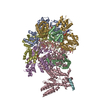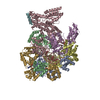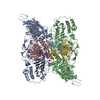+ Open data
Open data
- Basic information
Basic information
| Entry | Database: EMDB / ID: EMD-30850 | |||||||||
|---|---|---|---|---|---|---|---|---|---|---|
| Title | voltage-gated sodium channel Nav1.5-E1784K | |||||||||
 Map data Map data | Cryo-EM map of voltage-gated sodium channel | |||||||||
 Sample Sample |
| |||||||||
| Function / homology |  Function and homology information Function and homology informationvoltage-gated sodium channel activity involved in AV node cell action potential / voltage-gated sodium channel activity involved in bundle of His cell action potential / voltage-gated sodium channel activity involved in SA node cell action potential / bundle of His cell action potential / AV node cell action potential / SA node cell action potential / AV node cell to bundle of His cell communication / membrane depolarization during SA node cell action potential / cardiac ventricle development / response to denervation involved in regulation of muscle adaptation ...voltage-gated sodium channel activity involved in AV node cell action potential / voltage-gated sodium channel activity involved in bundle of His cell action potential / voltage-gated sodium channel activity involved in SA node cell action potential / bundle of His cell action potential / AV node cell action potential / SA node cell action potential / AV node cell to bundle of His cell communication / membrane depolarization during SA node cell action potential / cardiac ventricle development / response to denervation involved in regulation of muscle adaptation / regulation of ventricular cardiac muscle cell membrane depolarization / regulation of atrial cardiac muscle cell membrane repolarization / membrane depolarization during atrial cardiac muscle cell action potential / voltage-gated sodium channel activity involved in Purkinje myocyte action potential / regulation of sodium ion transmembrane transport / brainstem development / membrane depolarization during AV node cell action potential / voltage-gated sodium channel activity involved in cardiac muscle cell action potential / membrane depolarization during bundle of His cell action potential / positive regulation of action potential / atrial cardiac muscle cell action potential / membrane depolarization during Purkinje myocyte cell action potential / telencephalon development /  cardiac conduction system development / regulation of atrial cardiac muscle cell membrane depolarization / membrane depolarization during cardiac muscle cell action potential / positive regulation of sodium ion transport / ventricular cardiac muscle cell action potential / membrane depolarization during action potential / cardiac muscle cell action potential involved in contraction / cardiac conduction system development / regulation of atrial cardiac muscle cell membrane depolarization / membrane depolarization during cardiac muscle cell action potential / positive regulation of sodium ion transport / ventricular cardiac muscle cell action potential / membrane depolarization during action potential / cardiac muscle cell action potential involved in contraction /  voltage-gated sodium channel complex / regulation of ventricular cardiac muscle cell membrane repolarization / regulation of cardiac muscle cell contraction / Interaction between L1 and Ankyrins / voltage-gated sodium channel complex / regulation of ventricular cardiac muscle cell membrane repolarization / regulation of cardiac muscle cell contraction / Interaction between L1 and Ankyrins /  voltage-gated sodium channel activity / voltage-gated sodium channel activity /  ankyrin binding / sodium ion transport / ankyrin binding / sodium ion transport /  fibroblast growth factor binding / fibroblast growth factor binding /  nitric-oxide synthase binding / Phase 0 - rapid depolarisation / regulation of heart rate by cardiac conduction / odontogenesis of dentin-containing tooth / nitric-oxide synthase binding / Phase 0 - rapid depolarisation / regulation of heart rate by cardiac conduction / odontogenesis of dentin-containing tooth /  membrane depolarization / membrane depolarization /  intercalated disc / lateral plasma membrane / sodium ion transmembrane transport / neuronal action potential / cardiac muscle contraction / intercalated disc / lateral plasma membrane / sodium ion transmembrane transport / neuronal action potential / cardiac muscle contraction /  T-tubule / cellular response to calcium ion / T-tubule / cellular response to calcium ion /  regulation of heart rate / cerebellum development / regulation of heart rate / cerebellum development /  caveola / positive regulation of epithelial cell proliferation / caveola / positive regulation of epithelial cell proliferation /  sarcolemma / Z disc / sarcolemma / Z disc /  scaffold protein binding / transmembrane transporter binding / scaffold protein binding / transmembrane transporter binding /  calmodulin binding / protein domain specific binding / calmodulin binding / protein domain specific binding /  axon / axon /  ubiquitin protein ligase binding / ubiquitin protein ligase binding /  nucleolus / nucleolus /  protein kinase binding / perinuclear region of cytoplasm / protein kinase binding / perinuclear region of cytoplasm /  enzyme binding / enzyme binding /  cell surface / cell surface /  endoplasmic reticulum / endoplasmic reticulum /  nucleoplasm / nucleoplasm /  membrane / membrane /  plasma membrane plasma membraneSimilarity search - Function | |||||||||
| Biological species |   Homo sapiens (human) Homo sapiens (human) | |||||||||
| Method |  single particle reconstruction / single particle reconstruction /  cryo EM / Resolution: 3.3 Å cryo EM / Resolution: 3.3 Å | |||||||||
 Authors Authors | Yan N / Pan X / Li Z | |||||||||
| Funding support |  China, 1 items China, 1 items
| |||||||||
 Citation Citation |  Journal: Proc Natl Acad Sci U S A / Year: 2021 Journal: Proc Natl Acad Sci U S A / Year: 2021Title: Structure of human Na1.5 reveals the fast inactivation-related segments as a mutational hotspot for the long QT syndrome. Authors: Zhangqiang Li / Xueqin Jin / Tong Wu / Xin Zhao / Weipeng Wang / Jianlin Lei / Xiaojing Pan / Nieng Yan /   Abstract: Na1.5 is the primary voltage-gated Na (Na) channel in the heart. Mutations of Na1.5 are associated with various cardiac disorders exemplified by the type 3 long QT syndrome (LQT3) and Brugada ...Na1.5 is the primary voltage-gated Na (Na) channel in the heart. Mutations of Na1.5 are associated with various cardiac disorders exemplified by the type 3 long QT syndrome (LQT3) and Brugada syndrome (BrS). E1784K is a common mutation that has been found in both LQT3 and BrS patients. Here we present the cryo-EM structure of the human Na1.5-E1784K variant at an overall resolution of 3.3 Å. The structure is nearly identical to that of the wild-type human Na1.5 bound to quinidine. Structural mapping of 91- and 178-point mutations that are respectively associated with LQT3 and BrS reveals a unique distribution pattern for LQT3 mutations. Whereas the BrS mutations spread evenly on the structure, LQT3 mutations are clustered mainly to the segments in repeats III and IV that are involved in gating, voltage-sensing, and particularly inactivation. A mutational hotspot involving the fast inactivation segments is identified and can be mechanistically interpreted by our "door wedge" model for fast inactivation. The structural analysis presented here, with a focus on the impact of mutations on inactivation and late sodium current, establishes a structure-function relationship for the mechanistic understanding of Na1.5 channelopathies. | |||||||||
| History |
|
- Structure visualization
Structure visualization
| Movie |
 Movie viewer Movie viewer |
|---|---|
| Structure viewer | EM map:  SurfView SurfView Molmil Molmil Jmol/JSmol Jmol/JSmol |
| Supplemental images |
- Downloads & links
Downloads & links
-EMDB archive
| Map data |  emd_30850.map.gz emd_30850.map.gz | 49.8 MB |  EMDB map data format EMDB map data format | |
|---|---|---|---|---|
| Header (meta data) |  emd-30850-v30.xml emd-30850-v30.xml emd-30850.xml emd-30850.xml | 11.4 KB 11.4 KB | Display Display |  EMDB header EMDB header |
| Images |  emd_30850.png emd_30850.png | 84.9 KB | ||
| Archive directory |  http://ftp.pdbj.org/pub/emdb/structures/EMD-30850 http://ftp.pdbj.org/pub/emdb/structures/EMD-30850 ftp://ftp.pdbj.org/pub/emdb/structures/EMD-30850 ftp://ftp.pdbj.org/pub/emdb/structures/EMD-30850 | HTTPS FTP |
-Related structure data
| Related structure data |  7dtcMC M: atomic model generated by this map C: citing same article ( |
|---|---|
| Similar structure data |
- Links
Links
| EMDB pages |  EMDB (EBI/PDBe) / EMDB (EBI/PDBe) /  EMDataResource EMDataResource |
|---|---|
| Related items in Molecule of the Month |
- Map
Map
| File |  Download / File: emd_30850.map.gz / Format: CCP4 / Size: 52.7 MB / Type: IMAGE STORED AS FLOATING POINT NUMBER (4 BYTES) Download / File: emd_30850.map.gz / Format: CCP4 / Size: 52.7 MB / Type: IMAGE STORED AS FLOATING POINT NUMBER (4 BYTES) | ||||||||||||||||||||||||||||||||||||||||||||||||||||||||||||||||||||
|---|---|---|---|---|---|---|---|---|---|---|---|---|---|---|---|---|---|---|---|---|---|---|---|---|---|---|---|---|---|---|---|---|---|---|---|---|---|---|---|---|---|---|---|---|---|---|---|---|---|---|---|---|---|---|---|---|---|---|---|---|---|---|---|---|---|---|---|---|---|
| Annotation | Cryo-EM map of voltage-gated sodium channel | ||||||||||||||||||||||||||||||||||||||||||||||||||||||||||||||||||||
| Voxel size | X=Y=Z: 1.0825 Å | ||||||||||||||||||||||||||||||||||||||||||||||||||||||||||||||||||||
| Density |
| ||||||||||||||||||||||||||||||||||||||||||||||||||||||||||||||||||||
| Symmetry | Space group: 1 | ||||||||||||||||||||||||||||||||||||||||||||||||||||||||||||||||||||
| Details | EMDB XML:
CCP4 map header:
| ||||||||||||||||||||||||||||||||||||||||||||||||||||||||||||||||||||
-Supplemental data
- Sample components
Sample components
-Entire : voltage-gated sodium channel
| Entire | Name: voltage-gated sodium channel Sodium channel Sodium channel |
|---|---|
| Components |
|
-Supramolecule #1: voltage-gated sodium channel
| Supramolecule | Name: voltage-gated sodium channel / type: complex / ID: 1 / Parent: 0 / Macromolecule list: #1 |
|---|---|
| Source (natural) | Organism:   Homo sapiens (human) Homo sapiens (human) |
| Recombinant expression | Organism:   Homo sapiens (human) Homo sapiens (human) |
-Macromolecule #1: Sodium channel protein type 5 subunit alpha
| Macromolecule | Name: Sodium channel protein type 5 subunit alpha / type: protein_or_peptide / ID: 1 / Number of copies: 1 / Enantiomer: LEVO |
|---|---|
| Source (natural) | Organism:   Homo sapiens (human) Homo sapiens (human) |
| Molecular weight | Theoretical: 231.744 KDa |
| Recombinant expression | Organism:   Homo sapiens (human) Homo sapiens (human) |
| Sequence | String: MASWSHPQFE KGGGARGGSG GGSWSHPQFE KGFDYKDDDD KGTMANFLLP RGTSSFRRFT RESLAAIEKR MAEKQARGST TLQESREGL PEEEAPRPQL DLQASKKLPD LYGNPPQELI GEPLEDLDPF YSTQKTFIVL NKGKTIFRFS ATNALYVLSP F HPIRRAAV ...String: MASWSHPQFE KGGGARGGSG GGSWSHPQFE KGFDYKDDDD KGTMANFLLP RGTSSFRRFT RESLAAIEKR MAEKQARGST TLQESREGL PEEEAPRPQL DLQASKKLPD LYGNPPQELI GEPLEDLDPF YSTQKTFIVL NKGKTIFRFS ATNALYVLSP F HPIRRAAV KILVHSLFNM LIMCTILTNC VFMAQHDPPP WTKYVEYTFT AIYTFESLVK ILARGFCLHA FTFLRDPWNW LD FSVIIMA YTTEFVDLGN VSALRTFRVL RALKTISVIS GLKTIVGALI QSVKKLADVM VLTVFCLSVF ALIGLQLFMG NLR HKCVRN FTALNGTNGS VEADGLVWES LDLYLSDPEN YLLKNGTSDV LLCGNSSDAG TCPEGYRCLK AGENPDHGYT SFDS FAWAF LALFRLMTQD CWERLYQQTL RSAGKIYMIF FMLVIFLGSF YLVNLILAVV AMAYEEQNQA TIAETEEKEK RFQEA MEML KKEHEALTIR GVDTVSRSSL EMSPLAPVNS HERRSKRRKR MSSGTEECGE DRLPKSDSED GPRAMNHLSL TRGLSR TSM KPRSSRGSIF TFRRRDLGSE ADFADDENST AGESESHHTS LLVPWPLRRT SAQGQPSPGT SAPGHALHGK KNSTVDC NG VVSLLGAGDP EATSPGSHLL RPVMLEHPPD TTTPSEEPGG PQMLTSQAPC VDGFEEPGAR QRALSAVSVL TSALEELE E SRHKCPPCWN RLAQRYLIWE CCPLWMSIKQ GVKLVVMDPF TDLTITMCIV LNTLFMALEH YNMTSEFEEM LQVGNLVFT GIFTAEMTFK IIALDPYYYF QQGWNIFDSI IVILSLMELG LSRMSNLSVL RSFRLLRVFK LAKSWPTLNT LIKIIGNSVG ALGNLTLVL AIIVFIFAVV GMQLFGKNYS ELRDSDSGLL PRWHMMDFFH AFLIIFRILC GEWIETMWDC MEVSGQSLCL L VFLLVMVI GNLVVLNLFL ALLLSSFSAD NLTAPDEDRE MNNLQLALAR IQRGLRFVKR TTWDFCCGLL RQRPQKPAAL AA QGQLPSC IATPYSPPPP ETEKVPPTRK ETRFEEGEQP GQGTPGDPEP VCVPIAVAES DTDDQEEDEE NSLGTEEESS KQQ ESQPVS GGPEAPPDSR TWSQVSATAS SEAEASASQA DWRQQWKAEP QAPGCGETPE DSCSEGSTAD MTNTAELLEQ IPDL GQDVK DPEDCFTEGC VRRCPCCAVD TTQAPGKVWW RLRKTCYHIV EHSWFETFII FMILLSSGAL AFEDIYLEER KTIKV LLEY ADKMFTYVFV LEMLLKWVAY GFKKYFTNAW CWLDFLIVDV SLVSLVANTL GFAEMGPIKS LRTLRALRPL RALSRF EGM RVVVNALVGA IPSIMNVLLV CLIFWLIFSI MGVNLFAGKF GRCINQTEGD LPLNYTIVNN KSQCESLNLT GELYWTK VK VNFDNVGAGY LALLQVATFK GWMDIMYAAV DSRGYEEQPQ WEYNLYMYIY FVIFIIFGSF FTLNLFIGVI IDNFNQQK K KLGGQDIFMT EEQKKYYNAM KKLGSKKPQK PIPRPLNKYQ GFIFDIVTKQ AFDVTIMFLI CLNMVTMMVE TDDQSPEKI NILAKINLLF VAIFTGECIV KLAALRHYYF TNSWNIFDFV VVILSIVGTV LSDIIQKYFF SPTLFRVIRL ARIGRILRLI RGAKGIRTL LFALMMSLPA LFNIGLLLFL VMFIYSIFGM ANFAYVKWEA GIDDMFNFQT FANSMLCLFQ ITTSAGWDGL L SPILNTGP PYCDPTLPNS NGSRGDCGSP AVGILFFTTY IIISFLIVVN MYIAIILENF SVATEESTKP LSEDDFDMFY EI WEKFDPE ATQFIEYSVL SDFADALSEP LRIAKPNQIS LINMDLPMVS GDRIHCMDIL FAFTKRVLGE SGEMDALKIQ MEE KFMAAN PSKISYEPIT TTLRRKHEEV SAMVIQRAFR RHLLQRSLKH ASFLFRQQAG SGLSEEDAPE REGLIAYVMS ENFS RPLGP PSSSSISSTS FPPSYDSVTR ATSDNLQVRG SDYSHSEDLA DFPPSPDRDR ESIV |
-Macromolecule #2: 2-acetamido-2-deoxy-beta-D-glucopyranose
| Macromolecule | Name: 2-acetamido-2-deoxy-beta-D-glucopyranose / type: ligand / ID: 2 / Number of copies: 9 / Formula: NAG |
|---|---|
| Molecular weight | Theoretical: 221.208 Da |
| Chemical component information |  ChemComp-NAG: |
-Experimental details
-Structure determination
| Method |  cryo EM cryo EM |
|---|---|
 Processing Processing |  single particle reconstruction single particle reconstruction |
| Aggregation state | particle |
- Sample preparation
Sample preparation
| Buffer | pH: 7.5 |
|---|---|
| Vitrification | Cryogen name: ETHANE |
- Electron microscopy
Electron microscopy
| Microscope | FEI TITAN KRIOS |
|---|---|
| Electron beam | Acceleration voltage: 300 kV / Electron source:  FIELD EMISSION GUN FIELD EMISSION GUN |
| Electron optics | Illumination mode: FLOOD BEAM / Imaging mode: BRIGHT FIELD Bright-field microscopy Bright-field microscopy |
| Image recording | Film or detector model: GATAN K3 (6k x 4k) / Average electron dose: 24.0 e/Å2 |
| Experimental equipment |  Model: Titan Krios / Image courtesy: FEI Company |
- Image processing
Image processing
| Initial angle assignment | Type: MAXIMUM LIKELIHOOD |
|---|---|
| Final angle assignment | Type: MAXIMUM LIKELIHOOD |
| Final reconstruction | Resolution.type: BY AUTHOR / Resolution: 3.3 Å / Resolution method: FSC 0.143 CUT-OFF / Number images used: 147600 |
 Movie
Movie Controller
Controller
















